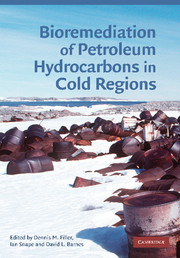Book contents
- Frontmatter
- Contents
- List of contributors
- Preface
- Glossary
- 1 Contamination, regulation, and remediation: an introduction to bioremediation of petroleum hydrocarbons in cold regions
- 2 Freezing and frozen soils
- 3 Movement of petroleum through freezing and frozen soils
- 4 Hydrocarbon-degrading bacteria in contaminated cold soils
- 5 Temperature effects on biodegradation of petroleum contaminants in cold soils
- 6 Analytical methods for petroleum in cold region soils
- 7 Treatability studies: microcosms, mesocosms, and field trials
- 8 Nutrient requirements for bioremediation
- 9 Landfarming
- 10 Thermally enhanced bioremediation and integrated systems
- 11 Emerging technologies
- References
- Index
6 - Analytical methods for petroleum in cold region soils
Published online by Cambridge University Press: 22 August 2009
- Frontmatter
- Contents
- List of contributors
- Preface
- Glossary
- 1 Contamination, regulation, and remediation: an introduction to bioremediation of petroleum hydrocarbons in cold regions
- 2 Freezing and frozen soils
- 3 Movement of petroleum through freezing and frozen soils
- 4 Hydrocarbon-degrading bacteria in contaminated cold soils
- 5 Temperature effects on biodegradation of petroleum contaminants in cold soils
- 6 Analytical methods for petroleum in cold region soils
- 7 Treatability studies: microcosms, mesocosms, and field trials
- 8 Nutrient requirements for bioremediation
- 9 Landfarming
- 10 Thermally enhanced bioremediation and integrated systems
- 11 Emerging technologies
- References
- Index
Summary
Introduction
In order to demonstrate the effectiveness of a bioremediation project, one must have an accurate measure of the contaminants, both at the start of the project and throughout the treatment process. The measurement of the contaminants throughout the process is important to demonstrate that the treatment is successful and to identify advances or set-backs quickly and effectively.
Proving the disappearance of hydrocarbons is important to the success of a bioremediation project. An accurate measurement of hydrocarbons and their biodegradation products is needed to confirm that petroleum was actually consumed by bacteria (discussed in Chapter 7, Section 7.3). One method of confirming biodegradation of petroleum is the coupled measurement of biodegradation rates by proxy methods and the disappearance of the contaminant. Biodegradation rates do not, in and of themselves, prove the decomposition of contaminants. Measurement of biodegradation rates, however, can be an easy way to demonstrate that the potential exists for contaminant removal. While measures of biodegradation rates are often used to estimate time to closure for a site, or proof of technology, biodegradation rates can be unreliable. Common measures of aerobic biodegradation are loss of contaminants, oxygen (O2) consumption, and carbon dioxide (CO2) evolution. Unfortunately, the CO2 can result from non-biological sources (see Chapter 7, Section 7.2.2.2 for additional discussion). Particularly in low pH groundwater, pH adjustment made during bioremediation could result in CO2 off-gassing from groundwater. Oxygen depletion in the subsurface is also not proof of biodegradation.
- Type
- Chapter
- Information
- Bioremediation of Petroleum Hydrocarbons in Cold Regions , pp. 109 - 124Publisher: Cambridge University PressPrint publication year: 2008
- 3
- Cited by

